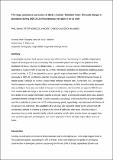Files in this item
The range, abundance and habitat of Hinde's Babbler Turdoides hindei : fine-scale changes in abundance during 2000-2011 reflect temporal variation in scrub cover
Item metadata
| dc.contributor.author | Shaw, P. | |
| dc.contributor.author | Njoroge, P. | |
| dc.contributor.author | Otieno, V. | |
| dc.contributor.author | Mlamba, E. | |
| dc.date.accessioned | 2015-01-16T15:01:03Z | |
| dc.date.available | 2015-01-16T15:01:03Z | |
| dc.date.issued | 2014-12-19 | |
| dc.identifier | 159067884 | |
| dc.identifier | 8327fd72-afa6-4b5b-b8db-80ecd145b624 | |
| dc.identifier | 84910602536 | |
| dc.identifier | 000345320500006 | |
| dc.identifier.citation | Shaw , P , Njoroge , P , Otieno , V & Mlamba , E 2014 , ' The range, abundance and habitat of Hinde's Babbler Turdoides hindei : fine-scale changes in abundance during 2000-2011 reflect temporal variation in scrub cover ' , Bird Conservation International , vol. 24 , no. 4 , pp. 453-465 . https://doi.org/10.1017/S0959270913000579 | en |
| dc.identifier.issn | 0959-2709 | |
| dc.identifier.other | ORCID: /0000-0002-8183-0289/work/143336059 | |
| dc.identifier.uri | https://hdl.handle.net/10023/6016 | |
| dc.description | We are extremely grateful to the British Ornithologists’ Union and the African Bird Club Conservation Fund, which generously co-funded fieldwork costs during 2011. | en |
| dc.description.abstract | In developing countries, 'land sparing' may be more effective than 'land sharing' in partially mitigating the impacts of farming on bird species diversity. We examined the pattern of change in the global and local distribution of Hinde's Babbler Turdoides hindei, a 'Vulnerable' Kenyan endemic whose local abundance is dependent on a passive form of land sharing, in which farmland is left fallow or abandoned, enabling Lantana scrub to colonise. In 2011 we assessed the species' global range and resurveyed three IBAs, surveyed previously in 2000-2001, to determine whether fine-scale changes in abundance reflected temporal changes in habitat quality. Although the babbler's known range increased between 1900-1970 and 1991-2011, we suggest that this apparent expansion largely reflects an improved knowledge base, and that several recently discovered sites are likely to have been overlooked in the past. In combination, the three IBAs surveyed in 2000-2001 and 2011 showed little net change in the number of individuals (+1.3%) or groups (-3.8%) encountered, despite a 68% decline in the number individuals recorded at one site. Within 1-km transect sections there was a positive correlation between change in Hinde's Babbler abundance and change in the amount of scrub cover available, such that a reduction in scrub cover of 22 and 6 percentage points, respectively, was associated with the loss of one group or one individual. The availability of scrub cover was dependent mainly on the amount land left uncultivated, perhaps in response to changes in the value of coffee and other crops. Since the babbler's abundance thus currently depends mainly on land sharing by default, rather than by design, we suggest that a more proactive approach, involving land purchase or payments for land set aside, might help to secure its future. | |
| dc.format.extent | 13 | |
| dc.format.extent | 652004 | |
| dc.language.iso | eng | |
| dc.relation.ispartof | Bird Conservation International | en |
| dc.subject | Demography | en |
| dc.subject | Range | en |
| dc.subject | Habitat change | en |
| dc.subject | Land sharing | en |
| dc.subject | Lantana | en |
| dc.subject | QH301 Biology | en |
| dc.subject.lcc | QH301 | en |
| dc.title | The range, abundance and habitat of Hinde's Babbler Turdoides hindei : fine-scale changes in abundance during 2000-2011 reflect temporal variation in scrub cover | en |
| dc.type | Journal article | en |
| dc.contributor.institution | University of St Andrews. School of Biology | en |
| dc.identifier.doi | 10.1017/S0959270913000579 | |
| dc.description.status | Peer reviewed | en |
This item appears in the following Collection(s)
Items in the St Andrews Research Repository are protected by copyright, with all rights reserved, unless otherwise indicated.

